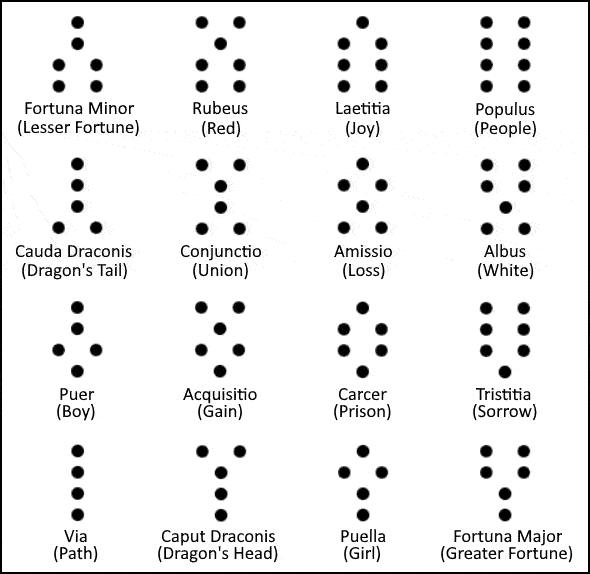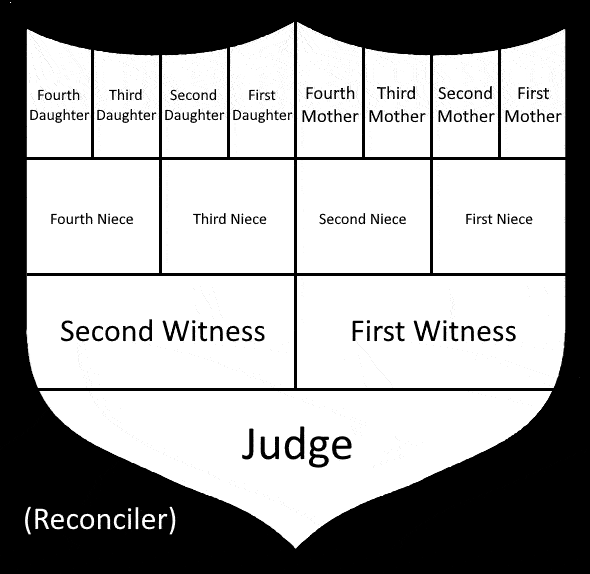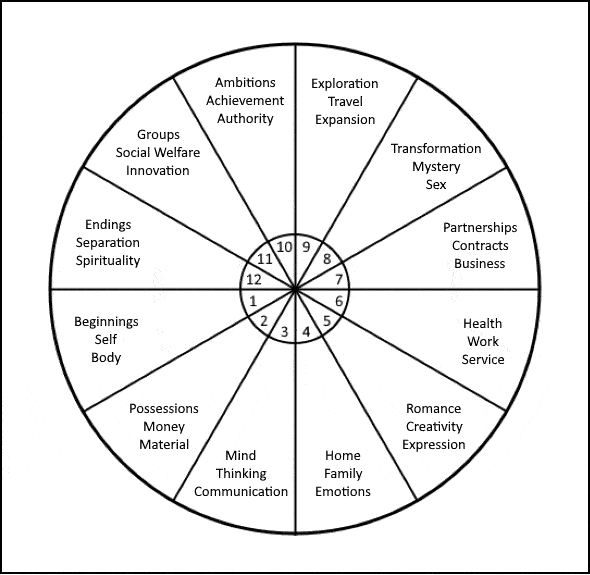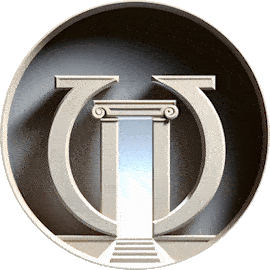Geomancy Oracle
What is Geomancy?
 The 16 Geomantic Figures
The 16 Geomantic Figures
Geomancy is an ancient method of divination based on the interpretation of marks or patterns in rock, sand or earth (hence the 'geo' in its name).
Early shamanic methods were varied and likely involved spontaneous interpretations of naturally-occurring shapes or inspired scribblings made on the ground.
In the medieval period, highly structured and codified forms of geomantic divination were developed by Islamic scholars and these later found their way into Western hermetic traditions.
The most well-known of these codified geomantic methods uses sixteen 'figures', each made up of four rows containing either one or two dots. The figures are generated using various systematic procedures.
The names of the sixteen figures reflect their traditional interpretive meanings. Some of these are 'good' or 'favorable' indicators such as Fortuna Major (Greater Fortune) or Laetitia (Joy). Others, such as Tristitia (Sorrow) or Amissio (Loss), are considered 'bad' or 'unfavorable'. A few, such as Puer (Boy) and Rubeus (Red), are more neutral or ambiguous, so that their precise significance can vary depending on the question and circumstances.
Geomantic Divination
Divination using the geomantic figures begins with your question. You should take care to word this carefully so that it precisely reflects the purpose of your enquiry and allows a clear answer.
While similar in many ways to the I Ching Oracle, you may find that geomantic readings provide a more detailed and concrete analysis of your situation.
You can ask a question about any topic on which you are uncertain how to proceed. For example, you might ask:
- Should I apply for the new job vacancy?
- Can I trust that Billy will remain faithful to me?
- What is the prognosis for my upcoming surgery?
- Is this a good time to invest in my friend's business?
- Should I consider postponing going to University for another year?
Having decided on your question, you should focus on and ponder it as you generate the geomantic reading.
If you want a quick answer, you can generate a single geomantic figure (the QUICK button on our tool) . This may help you decide, for example, whether or not to proceed, or what the most significant consideration may be.
For a more detailed analysis of your situation, we offer two other readings.
1. Shield Chart
 The Geomantic Shield
The Geomantic Shield
The traditional Shield Chart is a popular method for analysing an uncertain situation and providing clear guidance.
In this method, FIFTEEN figures are generated and placed at specific locations in a stylised shield diagram. An optional sixteenth figure (the Reconciler) can also be generated if interpretation requires further clarification.
The Final Four
The most important of the sixteen generated figures for interpretive purposes are the final four (the so-called First and Second Witnesses, the Judge and, optionally, the Reconciler.
First Witness indicates the INNER WORLD of the person asking the question and influences in the PAST.
Second Witness indicates OUTER CIRCUMSTANCES and tendencies that are likely affect the FUTURE.
Judge indicates the likely OUTCOME, especially as this may guide PRESENT action.
Reconciler (optionally) gives further guidance if the answer remains unclear after consideration of the Witnesses and Judge. Specifically it may indicate the likely FINAL CONSEQUENCES.
The Four Mothers
In addition to these, the Four Mothers (the initial figures from which all other figures are derived) can provide further insight.
First Mother reflects influences at the BEGINNING.
Second Mother suggests factors operating in EARLY DEVELOPMENT.
Third Mother suggests factors operating in LATER DEVELOPMENT.
Fourth Mother gives further insight into the FINAL OUTCOME.
Daughters and Nieces
Experienced geomancers sometimes also examine the remaining eight figures (the Four Daughters and Four Nieces) which may provide some additional guidance and analysis.
2. Astrological Chart
 The Twelve Astrological Houses
The Twelve Astrological Houses
In the medieval and later periods, astrologers in Europe who had discovered the Arabic texts on geomancy sought to integrate geomantic and astrological methods of divinatory analysis.
Various astrological approaches to geomancy have been devised over the centuries. The most popular method is based on placing the geomantic figures in the twelve HOUSES of an astrological chart.
Each house is traditionally associated with a specific area or aspect of human life and activity. For example, the first house indicates beginnings, the self and physical body, the second house represents possessions, money and other material concerns (see the house diagram).
When interpreting the astrological geomancy chart, the significance of each geomantic figure is understood to apply specifically to the area or aspect of human life corresponding to the astrological house.
After considering the significance of the geomantic figure appearing in each house, you can usually reflect more meaningfully on the four final figures (First and Second Witnesses, the Judge, and the Reconciler) which are interpreted exactly as for the Shield Chart.
While you may have a preference for either the Shield or Astrological charts, it can sometimes be useful and interesting to examine both charts on the same question. Because the sixteen geomantic figures are generated identically, it is a simple matter to SWITCH between the two charts. It is NOT necessary to generate a new set of figures.
How the Figures are Generated
There are many different ways that the geomantic figures can be cast, but all rely on procedures that generate a series of either ODD or EVEN outcomes.
Some methods use dice or cards. Others involve, for example, picking up and counting handfuls of stones or sticks. Modern approaches may use computerised random number generators.
Traditionally, the preferred method is to make a series of marks in the sand or on paper and then counting up whether these have an odd or even total. To ensure a random or indeterminate outcome, the marks themselves must be made without conscious counting.
To create a single geomantic figure, four such steps are needed, one for each row of the figure. If the count is ODD, the row has a single dot and, if EVEN, there are two dots.
For the SHIELD and ASTROLOGICAL charts, sixteen steps are required -- four steps for each of the four MOTHERS. The remaining twelve figures are then derived by various systematic transformations of the four Mothers.
About Geomancy Oracle
Our Geomancy Oracle is a free online divination tool that constructs and interprets geomantic charts. These can help you to clarify personal issues and guide you towards making better decisions.


Geomancy Oracle
by Psychic Science
This is PREMIUM content
You may be asked to view
a short ad to unlock the app
Auto Manual (Short) Manual (Full)
Using our Geomancy Oracle
Our free online Geomancy Oracle allows you to cast three different interpreted readings.
- A single geomantic figure (QUICK)
- A Shield Chart (SHIELD)
- An Astrological Chart (ASTRO)
You can also SWITCH easily between the Shield and Astrological charts for your question.
Additionally, you can choose betwen automated and manual input methods.
- The AUTO method uses a random number generator to create the necessary figures. No further input is required on your part.
- The MANUAL (SHORT) method is a variation of the traditional procedure in which marks are made in sand or drawn on paper. However, rather than making many marks for each row of a figure, only ONE mark per row is needed. The ODD or EVEN outcome is then determined by the pixel positions of the marks you make.
- The MANUAL (FULL) method is a more complete simulation of the traditional procedure. Here you must make several marks for each row of a figure. Note that you should NOT count your marks as you are making them. The more marks you make the better. At least four in each row are required although a common recommendation is at least twelve. In Arabic tradition, the marks should be made from right to left, but this is not necessary here.
Note that you do NOT need to know or understand exactly how the various figures are constructed. All necessary calculations are done automatically. If you wish to learn the methodological sequences involved for deriving each figure, you can find details in various books and other online resources (see Further Reading).
Before casting a reading, you should carefully frame your question. If you wish, you can type in the question. Neither your question, nor the reading is sent to our servers, or recorded by us. Typing in your question will encourage you to formulate and focus upon it effectively. The question will also be included if you choose to save the reading (you can COPY the chart as an image and also select and save the complete interpretive text to your clipboard).
About Our Interpretations
The Oracle gives brief indicative readings for each figure in the chart.
You should try to relate these readings to your question, bearing in mind that our texts give only general guidelines that have been formulated to apply to a range of typical situations. Hopefully the texts will provide the basis for your own creative interpretive responses.
You should find that the more you use the Geomancy Oracle and become familiar with the figures and charts, the better you will learn how to understand and benefit from the readings.
Further Reading
Greer, J.M. (2009). The Art and Practice of Geomancy: Divination, Magic, and Earth Wisdom of the Renaissance . Weiser Books.
Skinner, S. (2020). Geomancy in Theory and Practice. Golden Hoard.
Webster, R. (2010). Geomancy for Beginners: Simple Techniques for Earth Divination. Llewellyn Publications.
Geomancy [Wikipedia]

